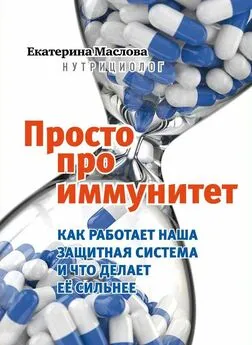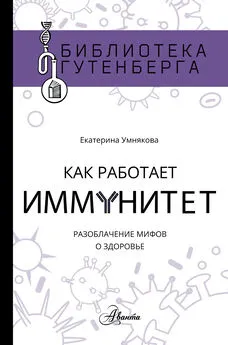Екатерина Умнякова - Как работает иммунитет [litres]
- Название:Как работает иммунитет [litres]
- Автор:
- Жанр:
- Издательство:Литагент АСТ
- Год:2019
- Город:М.
- ISBN:978-5-17-112323-9
- Рейтинг:
- Избранное:Добавить в избранное
-
Отзывы:
-
Ваша оценка:
Екатерина Умнякова - Как работает иммунитет [litres] краткое содержание
Для широкого круга читателей.
Как работает иммунитет [litres] - читать онлайн бесплатно ознакомительный отрывок
Интервал:
Закладка:
Oiseth S.J., Aziz M.S. Cancer immunotherapy: a brief review of the history, possibilities, and challenges ahead. // J Cancer Metastasis Treat 2017. Vol. 3. P. 250–261.).
Leach D. R., Krummel M. F., Allison J. P. (1996). Enhancement of antitumor immunity by CTLA-4 blockade. // Science. 1996. Vol. 271, № 5256. P. 1734–1736;
Iwai Y., Terawaki S., Honjo T. PD-1 blockade inhibits hematogenous spread of poorly immunogenic tumor cells by enhanced recruitment of effector T cells. // Int Immunol. 2005. Vol. 17, № 2. P. 133–144.).
Li J., Li W., Huang K., Zhang Y., Kupfer G., Zhao Q. Chimeric antigen receptor T cell (CAR-T) immunotherapy for solid tumors: lessons learned and strategies for moving forward. // J Hematol Oncol. 2018. Vol. 11, № 1. Article 22;
Saudemont A., Jespers L., Clay T. Current status of gene engineering cell therapeutics. // Front Immunol. 2018. Vol. 9. Article 153.
Fenner F., Henderson D.A., Arita I., Jezek Z., Ladnyi I.D. Smallpox and its Eradication. Geneva: World Health Organization, 1988. WHO Library Database.
Dinc G., Ulman Y.I. The introduction of variolation ‘A La Turca’ to the West by Lady Mary Montagu and Turkey’s contribution to this. // Vaccine. 2007. Vol. 25, P. 4261–4265.
Gross C.P., Sepkowitz K.A. The myth of the medical breakthrough: smallpox, vaccination, and Jenner reconsidered. Int J Infect Dis 1998. Vol.3, № 1. P. 54–60.
Микиртичан Г.Л. Из истории вакцинопрофилактики: оспопрививание. Российский педиатрический журнал. 2016. Том. 19, С. 55–62.
Stefan Riedel. Edward Jenner and the History of Smallpox and Vaccination. Baylor University Medical Center Proceedings. 2005. Vol. 18, P. 21–25.
Pead P.J. Benjamin Jesty: new light in the dawn of vaccination. Lancet. 2003. Vol. 362. P. 2104–2109.
Baym M., Lieberman T.D., Kelsic E.D., Chait R., Gross R., Yelin I., Kishony R. Spatiotemporal microbial evolution on antibiotic landscapes. // Science. 2016. Vol. 353, № 6304. P. 1147–1151.
Pidot S.J., Gao W., Buultjens A.H., Monk I.R., Guerillot R., Carter G.P., Lee J.Y.H., Lam M.M.C., Grayson M.L., Ballard S.A., Mahony A.A., Grabsch E.A., Kotsanas D., Korman T.M., Coombs G.W., Robinson J.O., da Silva A.G., Seemann T., Howden B.P., Johnson P.D.R., Stinear T.P. Increasing tolerance of hospital Enterococcus faecium to handwash alcohols. // Science Translational Medicine. 2018. Vol. 10, № 452. eaar6115.
Basha S., Surendran N., Pichichero M. Immune responses in neonates. // Expert Rev Clin Immunol. 2014. Vol. 10, № 9. P. 1171–1184.
Adkins B., Leclerc C., Marshall-Clarke S. Neonatal adaptive immunity comes of age. // Nat Rev Immunol. 2004. Vol.4, № 7. P. 553–564.
Simon A.K., Hollander G.A., McMichael A. Evolution of the immune system in humans from infancy to old age. // Proc Biol Sci. 2015. Vol. 282, № 1821. Article 20143085.
Levy O. Innate immunity of the newborn: basic mechanisms and clinical correlates. // Nat Rev Immunol. 2007. Vol.7, № 5. P. 379–390.
Yang I., Corwin E.J., Brennan P.A., Murphy J.R. The infant microbiome: implications for infant health and neurocognitive development. // Nurs Res. 2016. Vol. 65, № 1. P. 76–88.
Reboldi A., Cyster J.G. Peyer’s patches: organizing B cell responses at the intestinal frontier. // Immunol Rev. 2016. Vol. 271, № 1. P. 230–245.
Eberl G., Lochner M. The development of intestinal lymphoid tissues at the interface of self and microbiota. // Mucosal Immunol. 2009. Vol. 2, № 6. P. 478–485.
Ballard O., Morrow A.L. Human milk composition: nutrients and bioactive factors. // Pediatr Clin North Am. 2013. Vol. 60, № 1. P. 49–74.
Martin C.R., Ling P-R., Blackburn G.L. Review of infant feeding: key features of breast milk and infant formula. // Nutrients. 2016. Vol. 8, № 5.
Adkins B., Leclerc C., Marshall-Clarke S. Neonatal adaptive immunity comes of age. // Nat Rev Immunol. 2004. Vol.4, № 7. P. 553–564.
Okada H., Kuhn C., Feillet H., Bach J-F. The ‘hygiene hypothesis’ for autoimmune and allergic diseases: an update. // Clin Exp Immunol. 2010. Vol. 160, № 1. P. 1–9.
Джессика Снейдер Сакс. «Микробы хорошие и плохие» М.: АСТ: CORPUS, 2014. – 496 c.
Gell P.G.H., Coombs R.R.A. The classification of allergic reactions underlying disease. // Clinical Aspects of Immunology. Blackwell Science. 1963.
Рёкен М., Гроверс Г., Бургдорф В.; Пер. с англ. Наглядная аллергология. М.: Бином. Лаборатория знаний. 2018, – 238 с.
Janeway C., Jr, Travers P., Walport M., Shlomchik M. Immunobiology, 5th edition. The Immune System in Health and Disease. New York: Garland Science; 2001
Basu S., Kaur R., Kaur G. Hemolytic disease of the fetus and newborn: Current trends and perspectives. // Asian J Transfus Sci. 2011. Vol. 5, № 1. P. 3–7
Stone S.F., Phillips E.J., Wiese M.D., Heddle R.J., Brown S.G.A. Immediate-type hypersensitivity drug reactions. // Br J Clin Pharmacol. 2014. Vol. 78, № 1. P. 1–13
Kumar V. K., Abbas A. K., Aster J.C. Hypersensitivity: immunologically mediated tissue injury. Robbins & Cotran Pathologic Basis of Disease (9th ed.). Elsevier Health Sciences. 2014. P. 200–211.
Шенфельд И., Мерони П.Л., Чурилов Л.П… Руководство по аутоиммунным заболеваниям для врачей общей практики; пер. с англ. СПб.: Элби-СПб. 2017, – 416 с.
Uzzaman A., Cho S.H.Chapter 28: Classification of hypersensitivity reactions. // Allergy Asthma Proc. 2012. Vol. 33, Suppl 1. P. 96–99.
Orme I.M., Andersen P., Boom W.H. T cell response to Mycobacterium tuberculosis. // J Infect Dis. 1993. Vol. 167. P. 1481–1497.
Encinales L., Zuñiga J., Yunis M., Granados-Montiel J., Granados J., Almeciga I., Clavijo O., Awad C., Collazos V., Vargas-Rojas M.I., Bañales-Mendez J.L., Vazquez-Castañeda L., Stern J.N., Romero V., Frindkis-Hareli M., Terreros D., Fernandez-Viña M., Yunis E.J. Humoral immunity in tuberculin skin test anergy and its role in high-risk persons exposed to active tuberculosis. // Mol Immunol. 2010. Vol. 47, № 5. Article 1066.
Palm N.W., Rosenstein R.K., Medzhitov R. Allergic host defences. // Nature. 2012. Vol. 484, № 7395. P. 465–472.
Мечников И.И. «Этюды оптимизма» М.: Наука, Главная редакция литературы на ин. яз., 1988. – 328 с.
Мечников И.И. «Этюды о человеческой природе» СПб.: Азбука, Азбука-Аттикус, 2016. – 320 с.
Hillman E.T., Lu H., Yao T., Nakatsu C.H. Microbial ecology along the gastrointestinal tract // Microbes Environ. 2017. Vol. 32, № 4. P. 300–313.
Tanaka M., Nakayama. Development of the gut microbiota in infancy and its impact on health in later life // J. Allergology International. 2017. Vol. 66, № 4. P. 515–522.
Ramakrishna B.S.Role of the gut microbiota in human nutrition and metabolism // J Gastroenterol Hepatol. 2013. Vol. 28, № 4. P. 9–17.
Джессика Снейдер Сакс. «Микробы хорошие и плохие» М.: АСТ: CORPUS, 2014. – 496 c.
Sanders M.E., Guarner F., Guerrant R., Holt P.R., Quigley E.M., Sartor R.B., Sherman P.M., Mayer E.A. An update on the use and investigation of probiotics in health and disease // Gut. 2013. Vol. 62 № 5: 787–796.
Degnan F.H. The US Food and Drug Administration and probiotics: regulatory categorization // Clin Infect Dis. 2008. Vol. 46, № 2: S133-136; discussion S144-151.
Hill C., Guarner F., Reid G., Gibson G.R., Merenstein D.J., Pot B., Morelli L., Canani R.B., Flint H.J., Salminen S., Calder P.C., Sanders M.E.Expert consensus document. The International Scientific Association for Probiotics and Prebiotics consensus statement on the scope and appropriate use of the term probiotic. // Nat Rev Gastroenterol Hepatol. 2014. Vol. 1, № 8. P. 506–514.
McGhee J.R., Fujihashi K. Inside the mucosal immune system // PLoS Biol. 2012. Vol. 10, № 9: e1001397.
Eberl G., Lochner M. The development of intestinal lymphoid tissues at the interface of self and microbiota // Mucosal Immunol. 2009. Vol. 2, № 6. P:478–485.
Jung C., Hugot J-P., Barreau F. Peyer’s patches: the immune sensors of the intestine // Int J Inflam. 2010; 2010: 823710.
Hemarajata P., Versalovic J.Effects of probiotics on gut microbiota: mechanisms of intestinal immunomodulation and neuromodulation // Therap Adv Gastroenterol. 2013. Vol. 6, № 1. P. 39–51.
Bender D.A. Nutritional biochemistry of the vitamins. Cambridge, U.K.: Cambridge University Press. 2003. 488 pp.
Mora J.R., Iwata M., von Andrian U.H. Vitamin effects on the immune system: vitamins A and D take centre stage // Nat Rev Immunol. 2008. Vol. 8, № 9, P. 685–698.
World Health Organization, Food and Agricultural Organization of the United Nations. Vitamin and mineral requirements in human nutrition. Second edition. 2004. 341 pp.
Prevention of neural tube defects: results of the Medical Research Council Vitamin Study. MRC Vitamin Study Research Group, authors. // Lancet. 1991. Vol. 338. P. 131–137;
Rieder MJ. Prevention of neural tube defects with periconceptional folic acid. Clin Perinatol. 1994;21:483–503; Pitkin RM. Folate and neural tube defects. // Am J Clin Nutr. 2007. Vol. 85. P. 285S–288S;
De Wals P, Tairou F, Van Allen MI, et al. Reduction in neural-tube defects after folic acid fortification in Canada. // N Engl J Med. 2007. Vol. 357. P. 135–142
Hamishehkar H., Ranjdoost F., Asgharian P., Mahmoodpoor A., Sanaie S. Vitamins, Are They Safe? // Adv Pharm Bull, 2016. Vol. 6, № 4. P. 467–477
Hemilä H.Vitamin C and the common cold // British Journal of Nutrition. 1992. Vol. 67. P. 3–16
Cowan D.W., Dieh H.S., Baker A.B. Vitamins for the prevention of colds // JAMA. 1942. Vol.120, № 16, P. 1268–1271.
Hemilä H., Chalker E.Vitamin C for preventing and treating the common cold // Cochrane Database Syst Rev. 2013. № 1. CD000980.
Lonn E., Bosch J., Yusuf S., Sheridan P., Pogue J., Arnold J.M., Ross C., Arnold A., Sleight P., Probstfield J., Dagenais G.R. Effects of long-term vitamin E supplementation on cardiovascular events and cancer: a randomized controlled trial // JAMA. 2005. Vol. 293, № 11. P. 1338–1347.
Bjelakovic G., Nikolova D., Gluud L.L., Simonetti R.G., Gluud C. Antioxidant supplements for prevention of mortality in healthy participants and patients with various diseases // Cochrane Database Syst Rev. 2012. № 3. CD007176.
Martínez M.E., Jacobs E.T., Baron J.A., Marshall J.R., Byers T. Dietary supplements and cancer prevention: balancing potential benefits against proven harms // J Natl Cancer Inst. 2012. Vol. 104, № 10. P. 732–739.
Klein E.A., Thompson I.M., Tangen C.M., et al. Vitamin E and the risk of prostate cancer. The Selenium and vitamin E cancer prevention trial (SELECT) // JAMA. 2011. Vol. 306, № 14. P. 1549–1556.
Miller E.R. 3rd, Pastor-Barriuso R., Dala D., Riemersma R.A., Appel L.J., Guallar E. Meta-analysis: high-dosage vitamin E supplementation may increase all-cause mortality // Ann Intern Med. 2005. Vol. 142, № 1, P. 37–46.
Lawson K.A., Wright M.E., Subar A., Mouw T., Hollenbeck A., Schatzkin A., Leitzmann M.F.Multivitamin use and risk of prostate cancer in the National Institutes of Health-AARP Diet and Health Study // J Natl Cancer Inst. 2007. Vol. 99, № 10, P. 754–764
Читать дальшеИнтервал:
Закладка:
![Обложка книги Екатерина Умнякова - Как работает иммунитет [litres]](/books/1082598/ekaterina-umnyakova-kak-rabotaet-immunitet-litres.webp)
![Екатерина Мекачима - За тридевять земель [litres]](/books/1056641/ekaterina-mekachima-za-tridevyat-zemel-litres.webp)
![Екатерина Васина - Да, детка, это – реальность! [litres]](/books/1057960/ekaterina-vasina-da-detka-eto-realnost-lit.webp)
![Екатерина Урузбиева - Охота на Тени [litres]](/books/1062038/ekaterina-uruzbieva-ohota-na-teni-litres.webp)
![Екатерина Флат - В погоне за тайной [litres]](/books/1063073/ekaterina-flat-v-pogone-za-tajnoj-litres.webp)
![Екатерина Рождественская - Балкон на Кутузовском [litres]](/books/1064280/ekaterina-rozhdestvenskaya-balkon-na-kutuzovskom-li.webp)
![Екатерина Звонцова - Серебряная клятва [litres]](/books/1064926/ekaterina-zvoncova-serebryanaya-klyatva-litres.webp)
![Екатерина Елизарова - Хранительница дракона [litres]](/books/1066933/ekaterina-elizarova-hranitelnica-drakona-litres.webp)
![Екатерина Соболь - Призрачный сыщик [litres]](/books/1143957/ekaterina-sobol-prizrachnyj-sychik-litres.webp)

